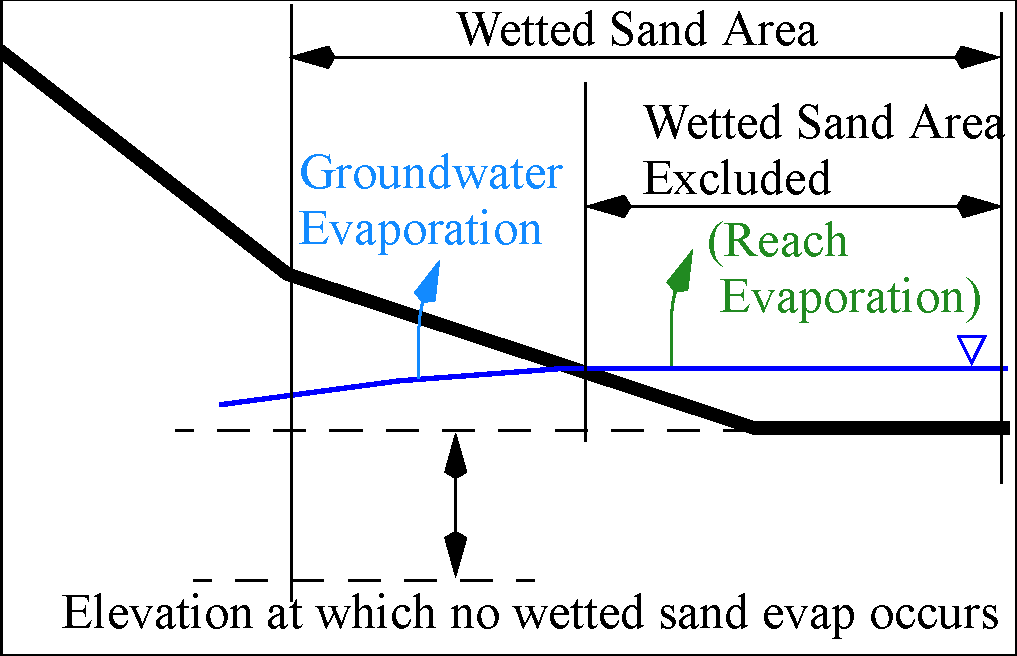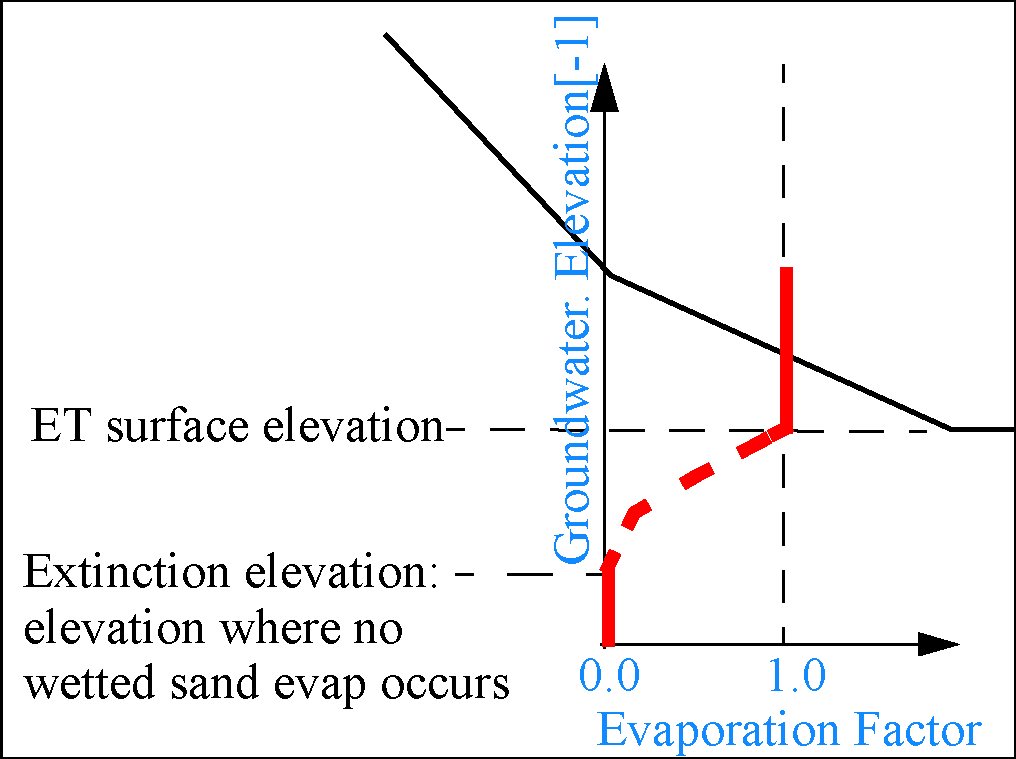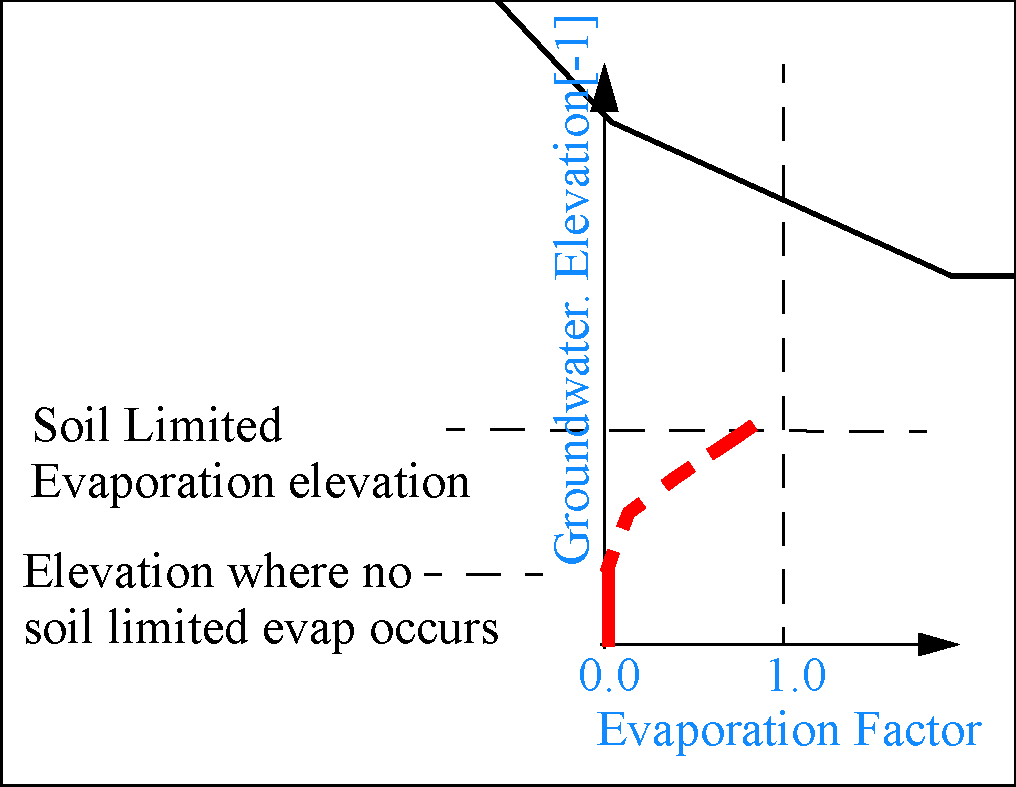Groundwater Evaporation
This category contains two methods: None and Wetted Sand Evaporation. These methods are only available when the Connected Groundwater Object method is selected in the Solution Type category.
This is the default method. It performs no calculations, and evaporation is assumed to be zero.
There are no slots specific to this method.
This method computes the evaporation that occurs from the wetted sand of the shallow groundwater. As shown in the half cross section in Figure 15.3, the groundwater evaporation comes from the wetted sand in the shallow groundwater that is adjacent to the water surface, but optionally, does not include the water surface. The area that contributes to the Evaporation is the Wetted Sand Area minus the Wetted Sand Area Excluded. The final evaporation is then computed using this reduced area, a coefficient, and the evaporation rate. The evaporation rate decreases from the pan evaporation rate at the surface to zero at some depth. This decrease in the rate of evaporation is simulated by a table that relates the elevation to the percent of the Pan Evaporation Rate at that elevation. Also, if there is no flow in the reach and the elevation is below a certain threshold level, the evaporation is limited to a reduced periodic rate.
Figure 15.3

This method was designed to work with a connected Reach object where the reach computes its Surface Area (see Pan Evaporation) and then propagates the value to the Wetted Sand Area Excluded. In this linking approach, evaporation from the water surface comes from the Reach while evaporation from the wetted sand comes out of the groundwater.
Figure 15.4

Slots Specific to This Method
Evaporation
Type: Series Slot
Units: Volume
Description: This slot is the output to the method. It holds the losses as calculated by the equation.
Information:
I/O: Output only
Links: Not linkable
Elevation Evaporation Factor Table
Type: Table
Units: Length vs Decimal
Description: This table relates the groundwater elevation with a factor that is used to compute the fraction of pan evaporation that occurs at that elevation.
Information: The values should be between 0.0 and 1.0 (0% to 100%), inclusive. The factor should be zero at (and below) the elevation at which no evaporation will occur. It should be 1.0 at (and above) the ET surface elevation (typically the streambed elevation of the reach above). See the diagram and the table for a view of what this table should represent.
Note: The Elevations must be in increasing order.

I/O: Required input
Links: NA
Data to enter in the slot | ||
|---|---|---|
Elevation | Pan Evaporation Factor | |
5460 | 0.0 | |
Elevation at extinction depth | 5490 | 0.0 |
5491 | 0.2 | |
5492 | 0.5 | |
5493 | 0.8 | |
5494 | 0.9 | |
ET surface elevation | 5495 | 1.0 |
Full Channel Elevation | 5500 | 1.0 |
Pan Coefficient
Type: Periodic
Units: No Units
Description: This slot holds a coefficient that is applied to the computation.
Information: The coefficient should be between 0 and 1.0.
I/O: Required input
Links: NA
Pan Evaporation
Type: Series
Units: Velocity (Length/Time)
Description: This slot contains the pan evaporation rate.
Information: This slot must have a valid input or an error will occur.
I/O: Input only
Links: Can be linked
Soil Limited Evaporation Factor Table
Type: Table
Units: Length vs Decimal
Description: This table relates the groundwater elevation with a factor that is used to compute the fraction of soil limited evaporation that occurs at that elevation.
Information: The values should be between 0.0 and 1.0 (0% to 100%), inclusive. The factor should be zero at (and below) the elevation at which no evaporation will occur. The largest factor should be at the Soil Limited Evaporation Elevation (see Soil Limited Evaporation Elevation). See the diagram and the table for a view of what this table should represent.
Note: The Elevations must be in increasing order.

I/O: Required input if Soil Limited Evaporation Elevation is specified
Links: NA
Data to enter in the slot | ||
|---|---|---|
Elevation | Soil Limited Evaporation Factor | |
Elevation where no soil limited evap occurs | 5490 | 0.0 |
5495 | 0.5 | |
Soil Limited Evaporation Elevation | 5495.5 | 0.9 |
Soil Limited Evaporation Rate
Type: Periodic
Units: Velocity (Length/Time)
Description: The evaporation rate when there is no area to be excluded and the water table elevation is below the Soil Limited Evaporation Elevation; see Soil Limited Evaporation Elevation.
Information:
I/O: Input required when Soil Limited Evaporation Elevation is specified
Links: NA
Soil Limited Evaporation Elevation
Type: Scalar
Units: Length (elevation)
Description: The elevation at which evaporation is only limited by the soil above, not the pan evaporation rates.
Information: If this slot is not specified, then the method will always use the second equation below; Soil Limiting Evaporation will not be modeled.
I/O: Optional input
Links: No
Wetted Sand Area
Type: Scalar
Units: Area
Description: The horizontal area of the groundwater that is considered wetted and could cause evaporation.
Information: This area includes any surface area of connected reaches
I/O: Input only
Links: NA
Wetted Sand Area Excluded
Type: Series Slot
Units: Area
Description: The wetted sand area that should not be included in the computation
Information: This provides a slot to adjust the wetted surface area based on current conditions.
I/O: If not input, set by a rule, or linked, it is assumed to be zero.
Links: Linkable. Typically, this slot is linked to the Surface Area on the Reach directly above this groundwater object
Method Details
This method will be executed from the Solve given Inflow from Surface Water dispatch method before mass balance takes place.
1. First, if the Wetted Sand Area Excluded is linked but not valid, the Groundwater object will exit the dispatch method and wait for the connected object to compute a value. Otherwise, if it is not valid, the Wetted Sand Area Excluded will default to 0 (but will not be set).
2. If the Wetted Sand Area Excluded is greater than or equal to the Wetted Sand Area, the Evaporation is set to zero and the method stops executing. This meets the need that wetted sand evaporation does not occur if the channel is full.
3. If the Soil Limited Evaporation Elevation is valid, the Elevation Previous is less than or equal to Soil Limited Evaporation Elevation, and the Wetted Sand Area Excluded is equal to zero. Then the previous Elevation is looked up on the Soil Limited Evaporation Rate periodic slot to get the soil limited evaporation rate that would occur on that date. This is stored as a temporary variable tempSoilLimitedEvaporationRate. Also, the previous Elevation is looked up on the Elevation Evaporation Factor Table to get the fraction of Soil Limited Evaporation Rate that occurs at that elevation. This is stored as a temporary variable tempSoilLimitedEvapFactor. The evaporation (flow) is computed as follows:
4. When the above conditions are not true, the previous Elevation is looked up on the Elevation Evaporation Factor Table to get the fraction of pan evaporation that occurs at that elevation. This is stored as a temporary variable tempElevEvapFactor. Then, the evaporation (flow) is computed as follows:
5. Finally, the Evaporation Flow is converted to a volume and saved as a local Evaporation variable.
6. The method finishes and exits. The dispatch method sets the Evaporation slot and subtracts it as a loss from the groundwater mass balance computation.
See the following sections for details:
Revised: 06/06/2025